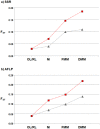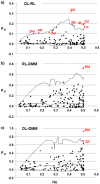European flint landraces grown in situ reveal adaptive introgression from modern maize
- PMID: 25853809
- PMCID: PMC4390310
- DOI: 10.1371/journal.pone.0121381
European flint landraces grown in situ reveal adaptive introgression from modern maize
Abstract
We have investigated the role of selection in the determination of the detected levels of introgression from modern maize hybrid varieties into maize landraces still cultivated in situ in Italy. We exploited the availability of a historical collection of landraces undertaken before the introduction and widespread use of modern maize, to analyse genomic changes that have occurred in these maize landraces over 50 years of co-existence with hybrid varieties. We have combined a previously published SSR dataset (n=21) with an AFLP loci dataset (n=168) to provide higher resolution power and to obtain a more detailed picture. We show that selection pressures for adaptation have favoured new alleles introduced by migration from hybrids. This shows the potential for analysis of historical introgression even over this short period of 50 years, for an understanding of the evolution of the genome and for the identification of its functionally important regions. Moreover, this demonstrates that landraces grown in situ represent almost unique populations for use for such studies when the focus is on the domesticated plant. This is due to their adaptation, which has arisen from their dynamic evolution under a continuously changing agro-ecological environment, and their capture of new alleles from hybridisation. We have also identified loci for which selection has inhibited introgression from modern germplasm and has enhanced the distinction between landraces and modern maize. These loci indicate that selection acted in the past, during the formation of the flint and dent gene pools. In particular, the locus showing the strongest signals of selection is a Misfit transposable element. Finally, molecular characterisation of the same samples with two different molecular markers has allowed us to compare their performances. Although the genetic-diversity and population-structure analyses provide the same global qualitative pattern, which thus provides the same inferences, there are differences related to their natures and characteristics.
Conflict of interest statement
Figures






Similar articles
-
Introgression from modern hybrid varieties into landrace populations of maize (Zea mays ssp. mays L.) in central Italy.Mol Ecol. 2009 Feb;18(4):603-21. doi: 10.1111/j.1365-294X.2008.04064.x. Mol Ecol. 2009. PMID: 19215582
-
A comprehensive study of the genomic differentiation between temperate Dent and Flint maize.Genome Biol. 2016 Jul 8;17(1):137. doi: 10.1186/s13059-016-1009-x. Genome Biol. 2016. PMID: 27387028 Free PMC article.
-
Genetic diversity in the germplasm of tropical maize landraces determined using molecular markers.Genet Mol Res. 2013 Jan 22;12(1):99-114. doi: 10.4238/2013.January.22.8. Genet Mol Res. 2013. PMID: 23359029
-
Diversity in global maize germplasm: characterization and utilization.J Biosci. 2012 Nov;37(5):843-55. doi: 10.1007/s12038-012-9227-1. J Biosci. 2012. PMID: 23107920 Review.
-
Tracking footprints of maize domestication and evidence for a massive selective sweep on chromosome 10.Proc Natl Acad Sci U S A. 2009 Jun 16;106 Suppl 1(Suppl 1):9979-86. doi: 10.1073/pnas.0901122106. Epub 2009 Jun 15. Proc Natl Acad Sci U S A. 2009. PMID: 19528660 Free PMC article. Review.
Cited by
-
Adaptive Introgression: An Untapped Evolutionary Mechanism for Crop Adaptation.Front Plant Sci. 2019 Feb 1;10:4. doi: 10.3389/fpls.2019.00004. eCollection 2019. Front Plant Sci. 2019. PMID: 30774638 Free PMC article. Review.
-
Characterization of Nutritional Quality Traits of a Common Bean Germplasm Collection.Foods. 2021 Jul 6;10(7):1572. doi: 10.3390/foods10071572. Foods. 2021. PMID: 34359442 Free PMC article.
-
Contemporary evolution of maize landraces and their wild relatives influenced by gene flow with modern maize varieties.Proc Natl Acad Sci U S A. 2019 Oct 15;116(42):21302-21311. doi: 10.1073/pnas.1817664116. Epub 2019 Sep 30. Proc Natl Acad Sci U S A. 2019. PMID: 31570572 Free PMC article.
-
Toward an Evolved Concept of Landrace.Front Plant Sci. 2017 Feb 8;8:145. doi: 10.3389/fpls.2017.00145. eCollection 2017. Front Plant Sci. 2017. PMID: 28228769 Free PMC article.
-
Beans (Phaseolus ssp.) as a Model for Understanding Crop Evolution.Front Plant Sci. 2017 May 8;8:722. doi: 10.3389/fpls.2017.00722. eCollection 2017. Front Plant Sci. 2017. PMID: 28533789 Free PMC article. Review.
References
-
- Anderson E. Hybridization of the habitat. Evolution. 1948;2: 1–9.
-
- Anderson E. Introgressive hybridization. New York: John Wiley; 1949.
-
- Rieseberg LH, Wendel J. Introgression and its consequences in plants In: Harrison R, editor. Hybrid Zones and the Evolutionary Process. New York: Oxford University Press; 1993. pp. 70–109.
-
- Rieseberg LH, Carney SE Plant hybridization. New Phytol. 1998;140: 599–624. - PubMed
-
- Whitney KD, Ahern JR, Campbell LG, Albert LP, King MS. Patterns of hybridization in plants. Perspect Plant Ecol Evol Syst. 2010;12: 175–182.
Publication types
MeSH terms
Substances
LinkOut - more resources
Full Text Sources
Other Literature Sources
Miscellaneous

